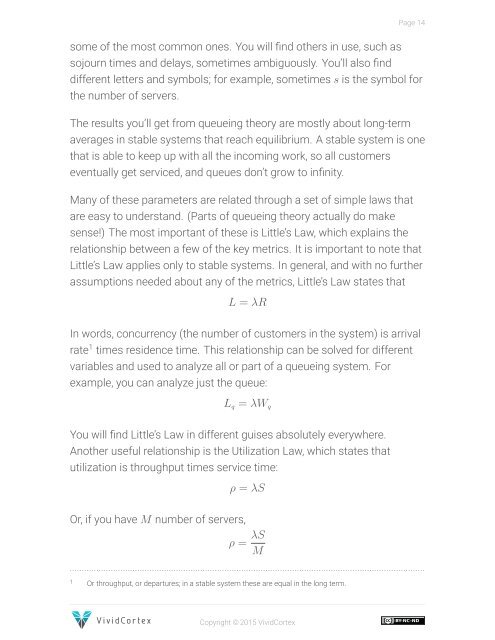Queueing Theory
The_Essential_Guide_to_Queueing_Theory
The_Essential_Guide_to_Queueing_Theory
Create successful ePaper yourself
Turn your PDF publications into a flip-book with our unique Google optimized e-Paper software.
Page 14<br />
some of the most common ones. You will find others in use, such as<br />
sojourn times and delays, sometimes ambiguously. You’ll also find<br />
different letters and symbols; for example, sometimes s is the symbol for<br />
the number of servers.<br />
The results you’ll get from queueing theory are mostly about long-term<br />
averages in stable systems that reach equilibrium. A stable system is one<br />
that is able to keep up with all the incoming work, so all customers<br />
eventually get serviced, and queues don’t grow to infinity.<br />
Many of these parameters are related through a set of simple laws that<br />
are easy to understand. (Parts of queueing theory actually do make<br />
sense!) The most important of these is Little’s Law, which explains the<br />
relationship between a few of the key metrics. It is important to note that<br />
Little’s Law applies only to stable systems. In general, and with no further<br />
assumptions needed about any of the metrics, Little’s Law states that<br />
L = λR<br />
In words, concurrency (the number of customers in the system) is arrival<br />
rate 1 times residence time. This relationship can be solved for different<br />
variables and used to analyze all or part of a queueing system. For<br />
example, you can analyze just the queue:<br />
L q = λW q<br />
You will find Little’s Law in different guises absolutely everywhere.<br />
Another useful relationship is the Utilization Law, which states that<br />
utilization is throughput times service time:<br />
ρ = λS<br />
Or, if you have M number of servers,<br />
ρ = λS<br />
M<br />
1<br />
Or throughput, or departures; in a stable system these are equal in the long term.<br />
Copyright © 2015 VividCortex


